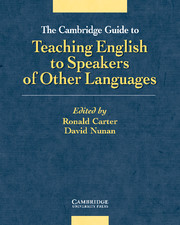Book contents
- Frontmatter
- Contents
- List of figures
- List of abbreviations
- Acknowledgements
- List of contributors
- Introduction
- Chapter 1 Listening
- Chapter 2 Speaking
- Chapter 3 Reading
- Chapter 4 Writing
- Chapter 5 Grammar
- Chapter 6 Vocabulary
- Chapter 7 Discourse
- Chapter 8 Pronunciation
- Chapter 9 Materials development
- Chapter 10 Second language teacher education
- Chapter 11 Psycholinguistics
- Chapter 12 Second language acquisition
- Chapter 13 Bilingualism
- Chapter 14 Sociolinguistics
- Chapter 15 Computer-assisted language learning
- Chapter 16 Observation
- Chapter 17 Classroom interaction
- Chapter 18 English for academic purposes
- Chapter 19 English for specific purposes
- Chapter 20 Assessment
- Chapter 21 Evaluation
- Chapter 22 Syllabus design
- Chapter 23 Language awareness
- Chapter 24 Language learning strategies
- Chapter 25 Task-based language learning
- Chapter 26 Literature in the language classroom
- Chapter 27 Genre
- Chapter 28 Programme management
- Chapter 29 Intercultural communication
- Chapter 30 On-line communication
- Postscript: The ideology of TESOL
- Glossary
- References
- Index
Chapter 27 - Genre
Published online by Cambridge University Press: 07 September 2010
- Frontmatter
- Contents
- List of figures
- List of abbreviations
- Acknowledgements
- List of contributors
- Introduction
- Chapter 1 Listening
- Chapter 2 Speaking
- Chapter 3 Reading
- Chapter 4 Writing
- Chapter 5 Grammar
- Chapter 6 Vocabulary
- Chapter 7 Discourse
- Chapter 8 Pronunciation
- Chapter 9 Materials development
- Chapter 10 Second language teacher education
- Chapter 11 Psycholinguistics
- Chapter 12 Second language acquisition
- Chapter 13 Bilingualism
- Chapter 14 Sociolinguistics
- Chapter 15 Computer-assisted language learning
- Chapter 16 Observation
- Chapter 17 Classroom interaction
- Chapter 18 English for academic purposes
- Chapter 19 English for specific purposes
- Chapter 20 Assessment
- Chapter 21 Evaluation
- Chapter 22 Syllabus design
- Chapter 23 Language awareness
- Chapter 24 Language learning strategies
- Chapter 25 Task-based language learning
- Chapter 26 Literature in the language classroom
- Chapter 27 Genre
- Chapter 28 Programme management
- Chapter 29 Intercultural communication
- Chapter 30 On-line communication
- Postscript: The ideology of TESOL
- Glossary
- References
- Index
Summary
Introduction
The term genre is used in various educational contexts to refer to the recognisable and recurring patterns of everyday, academic and literary texts that occur within particular cultures. Those working with the notion of genre share a belief in the importance of cultural and social contexts of language use. They also share a concern with ways of assisting students, through effective engagement with texts, to become active and participating members of the cultures in which those texts play a part.
Background
The term genre has a long history, dating back to ancient Greeks and their study of rhetorical structure in different categories of the epic, lyric and dramatic. For many years the term has been commonly used to refer to particular kinds of literature or other media of creative expression (e.g. art or film). More recently, however, it has been used in a range of educational contexts to refer not only to types of literary texts, but also to the predictable and recurring texts that are part of everyday life (e.g. work, study). As Bakhtin (translation 1986) has argued, learning genres is a fundamental part of language development, and it is our ability to predict the compositional structure and length of genres that enables us to communicate.
The impact of genre in educational contexts is evident primarily in three major areas (Hyon 1996; Johns 2000): English for specific purposes (ESP), New Rhetoric studies and systemic functional linguistics. Although the boundaries between these areas are often blurred, distinctions are useful as they serve to highlight similarities and differences of how the notion of genre has been adopted as a theoretical construct and as a basis for practical teaching strategies.
- Type
- Chapter
- Information
- Publisher: Cambridge University PressPrint publication year: 2001
- 10
- Cited by



